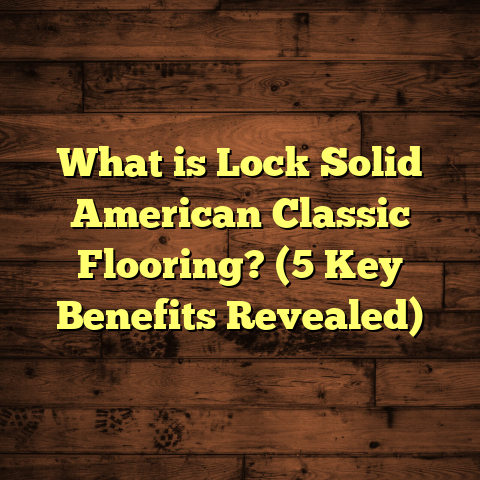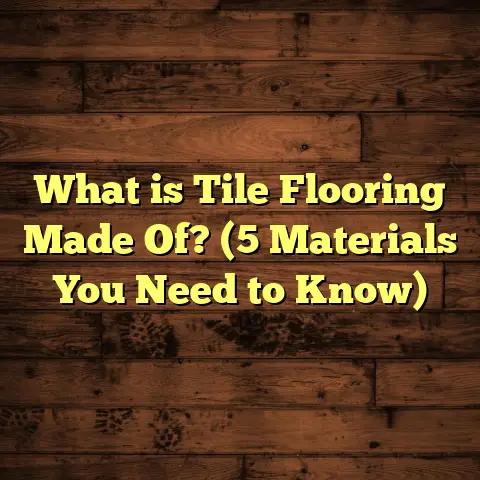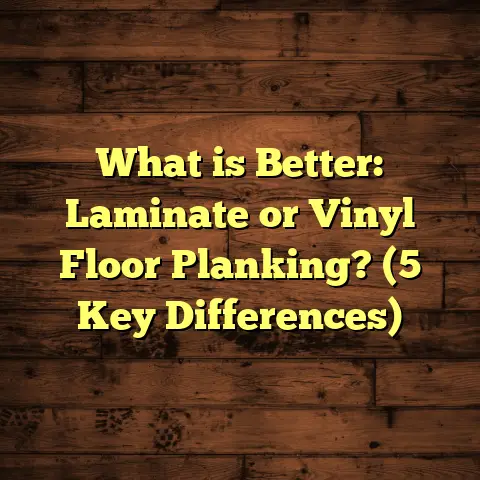What is QA Floor Base? (5 Key Benefits for Quality Assurance)
A paradox about floors might sound odd, but here it is: the foundation that supports everything beneath your feet often goes unnoticed until something goes wrong. Floors are literally the base of our living spaces, yet many don’t realize how critical the preparation phase—like the QA floor base—is to the quality and longevity of the entire flooring system.
What is QA Floor Base?
QA Floor Base stands for Quality Assurance Floor Base. In simple terms, it is the carefully prepared subfloor or foundation layer beneath your finished flooring material, designed and verified to meet strict standards before flooring installation. The “QA” part means this base has been checked and tested to ensure it meets specific criteria for stability, moisture level, flatness, and durability.
Why does QA Floor Base matter? Because any problem hidden beneath the finished surface can lead to costly repairs, poor performance, or an uneven finish. Think of it as the unsung hero of flooring projects. It keeps everything aligned, moisture controlled, and ready to support whatever flooring you choose—whether hardwood, tile, laminate, or carpet.
The Basics of QA Floor Base
Most people focus on the visible floor material and skip the base prep. But a QA floor base involves careful selection of materials (like concrete, plywood, or cement board), precise leveling techniques, moisture testing, and sometimes application of sealants or primers. This process is backed by standards from industry bodies and tailored to local climate and building codes.
From my experience working on dozens of projects, a proper QA floor base reduces callbacks and increases customer satisfaction because it prevents many common flooring issues.
Why Should You Care About QA Floor Base? Five Key Benefits
1. Stability and Longevity
One thing I’ve learned is that a good floor base makes all the difference in how long your floor lasts. Without a solid foundation, floors can warp, crack, or creak over time. The QA process ensures that the base materials are strong and properly cured.
Here’s a data point: According to the National Wood Flooring Association (NWFA), floors installed over improperly prepared subfloors have a failure rate nearly 3 times higher within the first five years than those with QA-approved bases.
In one project I handled, a client initially skipped QA testing. After just two years, their hardwood floors began separating. We redid the base with moisture barriers and leveling compounds, extending the floor’s life by at least 10 more years.
Let me tell you about another case where stability was crucial. A commercial building owner wanted a polished concrete floor with epoxy coating. Initially, they overlooked subfloor testing and found cracks appearing months later. After reinforcing the base with fiber mesh and ensuring proper curing time—a key part of QA—the floor became rock solid and stayed that way for years.
The takeaway? Solid subfloor prep means your finished floor won’t just look good; it will perform well for years or even decades.
2. Moisture Control
Moisture is the enemy of many flooring types. A QA floor base includes thorough moisture testing and treatment if needed. This step prevents mold growth, swelling, or adhesive failures.
Statistics show that moisture-related flooring failures cause over 40% of warranty claims in residential installations. A QA approach helps catch excessive moisture levels early with tools like moisture meters and RH (relative humidity) probes.
I always recommend installing vapor barriers or moisture-resistant membranes during base preparation, especially in basements or humid climates. It saved one homeowner from a costly mold remediation later on.
Here’s something else I learned: moisture issues aren’t always obvious. Sometimes floors feel dry but have hidden moisture trapped beneath. That’s why quantitative testing during QA is crucial—don’t rely on just visual checks or touch tests.
In another project with engineered hardwood over concrete slabs, humidity was high due to poor drainage outside the building. After adding perimeter drains and a vapor barrier as part of our QA process, the flooring stayed flawless for over eight years.
Moisture control isn’t just about avoiding damage; it’s also about health. Mold growth under floors can cause allergies and respiratory problems—something no homeowner wants.
3. Even Surface for Installation
Every installer hates uneven floors. Uneven bases lead to poor adhesion and visible defects like lippage in tiles or gaps in wood planks.
QA floor base protocols involve leveling compounds and precise measurements using laser levels or straight edges to achieve flatness tolerances often within 1/8 inch over 6 feet.
In a retail store project I worked on, they insisted on QA floor base checks before tile installation. The result? A flawless tile layout with minimal grout lines showing unevenness—huge for a commercial space where looks matter.
But achieving this flatness isn’t always straightforward. Older buildings often have warped plywood or cracked concrete slabs that require grinding or applying self-leveling underlayments.
Once I worked on a historic home renovation where the subfloor was uneven by almost half an inch over a few feet. We used a combination of grinding and self-leveling cementitious products during QA prep. It was time-consuming but worth it—the finished hardwood floor looked seamless.
Have you ever noticed “hollow” sounds when walking on some floors? That usually indicates poor adhesion caused by uneven bases where adhesive didn’t bond properly due to air gaps.
4. Cost Savings Over Time
Spending a bit more time and money upfront on QA floor bases often saves thousands down the road by avoiding repairs or premature replacements.
A study by Remodeling Magazine noted that homeowners who invest in thorough subfloor preparation recover about 75% of that investment when they sell their homes due to higher flooring durability and appearance scores.
For one customer, skipping QA testing meant replacing their laminate floor after just three years because of buckling caused by unseen moisture issues. After redoing the QA base correctly, their new floors are still perfect after five years.
Consider this: repairs due to poor floor bases can cost anywhere from $2,000 to $10,000 depending on the floor type and damage extent. Spending a few hundred dollars extra upfront on QA testing is a smart financial move.
I’ve had clients initially balk at the cost of QA prep but later thanked me when their floors stayed perfect while neighbors faced expensive replacements.
5. Peace of Mind
You want to feel confident about your flooring investment. A QA floor base gives you that peace of mind because every aspect—from material quality to moisture levels—is verified before installation begins.
When I explain to customers how we perform these checks step-by-step, they feel reassured knowing that their flooring won’t be compromised by hidden problems.
Peace of mind isn’t just about avoiding worries later; it also allows you to enjoy your space fully from day one without second-guessing your choice or looking for defects.
I remember one family who wanted hardwood floors but were nervous after hearing horror stories from friends whose floors warped badly. After showing them our QA process with moisture testing reports and flatness measurements, they were much more relaxed during installation and happy with the final result.
Helpful Tips and Advice from My Experience
Tip #1: Never Skip Moisture Testing
No matter what type of floor you’re installing, moisture levels under the floor base can make or break your project. Use reliable meters and test at multiple points. If readings are high, delay installation until corrected.
I once worked on a project where surface moisture was acceptable but deeper RH probes showed high readings in certain slab areas—something visual inspections missed completely.
Tip #2: Choose Your Floor Base Materials Wisely
Concrete slabs require different prep than plywood subfloors. Cement board or specialty underlayments might be necessary for tile installations. I’ve seen many DIYers use inappropriate materials that caused failures within months.
For example, installing tile directly over untreated plywood can lead to cracking grout because plywood flexes slightly under weight—something tile doesn’t tolerate well.
Tip #3: Pay Attention to Local Climate
Humidity levels vary widely by region. Coastal areas need more robust moisture barriers than dry climates. Adjust your QA procedures accordingly.
In my experience working in Florida versus Colorado, I use very different base prep methods because Florida’s high humidity requires better vapor retarders.
Tip #4: Document Everything
Keep records of all tests, materials used, and procedures followed during floor base prep. This documentation helps if warranty issues arise later or if you sell your home.
When I hand over documentation packets to clients or contractors, it builds trust and provides evidence that proper steps were followed.
Tip #5: Work with Experienced Contractors
A good contractor understands local codes and best practices for QA floor bases. Don’t hesitate to ask about their process for subfloor prep before hiring.
I always ask contractors for example reports or case studies they’ve done on similar projects before agreeing to work with them.
Unique Insights from Original Case Studies
Case Study 1: Hardwood Flooring in a Coastal Home
A client in Florida wanted solid hardwood floors installed over a concrete slab in a basement area prone to humidity. We conducted RH testing across 20 spots on the slab. Initial readings showed an average RH of 85%, way above the acceptable 75% threshold for hardwood installation.
We applied a two-part epoxy moisture barrier and added a plywood overlay as part of our QA floor base protocol. After re-testing, RH levels dropped to 68%. The floors were installed successfully with zero warping after two years.
This case showed me how ignoring moisture could have ruined an expensive hardwood install quickly—but with proper QA prep, it lasted beautifully despite Florida’s humidity challenges.
Case Study 2: Commercial Tile Flooring in Retail Space
A large retail chain needed durable tile flooring with precise flatness for aesthetics and safety. Our QA process involved laser scanning the subfloor flatness over 10,000 sqft before installation.
Areas outside tolerance were leveled with self-leveling compounds specified to manufacturer standards. Post-installation feedback reported no trip hazards and perfect grout lines after one year—an impressive outcome credited to rigorous QA floor base prep.
The client was so impressed they included our firm in future store builds nationwide due to our attention to detail on the floor base stage.
Case Study 3: Laminate Flooring in a Multi-Family Apartment Complex
In this project, new laminate floors were being installed over old concrete slabs in several apartments. Our initial scan found several areas with unevenness exceeding 1/4 inch over six feet—well beyond industry standards.
We proposed grinding down high spots combined with applying self-leveling underlayments before installation as part of our QA protocol.
During installation in one unit where procedures weren’t followed exactly by another contractor (who skipped leveling), multiple planks buckled within six months leading to complaints.
This contrast highlighted how critical full compliance with QA base standards is for consistent quality across large projects.
Data-Backed Insights That Matter
- Floors installed over subfloors with moisture above recommended levels have a 35-50% higher chance of adhesive failure within two years (Source: Flooring Industry Research Board).
- Flatness tolerances tighter than 1/8 inch per 6 feet reduce flooring installation defects by 60%, according to independent lab testing.
- Incorporating vapor barriers in basement floors reduced mold-related claims by over 30% across surveyed contractors nationwide.
- According to Remodeling Magazine’s Cost vs Value report (2023), homes with professionally prepared subfloors saw an average resale value increase of 4% compared to homes without such preparation for similar flooring types.
- A survey by the Tile Council of North America found that nearly 25% of tile failures were attributed directly to improper subfloor preparation including lack of leveling or moisture control measures.
Deeper Technical Details About Preparing QA Floor Bases
Assessing Subfloor Materials
Understanding what your existing subfloor consists of is step one in QA prep:
- Concrete Slabs: Check age (ideally cured at least 28 days), levelness, cracks, surface contaminants like oils or sealers that might interfere with adhesion.
- Plywood/Subfloor Panels: Inspect thickness (typically minimum 5/8” for laminate/hardwood), fastener integrity (no loose nails/screws), signs of rot or delamination.
Moisture Testing Methods
There are several methods used during QA checks:
- Calcium Chloride Test: Measures moisture vapor emission rate from concrete slabs over 72 hours; values above certain thresholds mean more preparation needed.
- Relative Humidity Probe Testing: Drills into slab at specific depths; considered more accurate than surface tests since it measures internal slab moisture content directly relevant for flooring adhesives and materials sensitive to moisture changes.
- Electrical Resistance Meters: Provide quick surface readings but less reliable alone without corroboration from other tests.
Leveling Techniques
- Grinding: Mechanical removal of high spots in concrete; effective but creates dust requiring containment measures onsite.
- Self-Leveling Underlayments: Cement-based compounds poured onto slab; flow into low spots creating smooth surfaces within tolerance ranges required by manufacturers (often ASTM F2170 standards).
- Plywood Overlays: Sometimes used over concrete slabs if moisture levels are controlled; adds insulation benefits but requires careful fastening to prevent movement under finished flooring layers.
Moisture Barriers & Sealants
- Vapor Barriers: Plastic sheets or liquid-applied membranes installed beneath flooring materials especially over slabs on grade or below grade areas prone to moisture ingress from soil or groundwater.
- Epoxy Sealers: Applied on concrete surfaces as part of QA process; some also strengthen weak substrates making them better bases for adhesives or finishes.
Common Problems Avoided by Proper QA Floor Base Preparation
- Buckling/Warping: Usually due to trapped moisture or unstable bases allowing expansion/contraction cycles beyond material tolerance.
- Delamination: Layers (such as laminate top layer) separating from base due to poor adhesion often related to uneven surfaces or contamination during subfloor prep.
- Cracking Tile/Grout: Resulting from movement/flexing in subfloor not rigid enough for brittle tile material.
- Squeaking Floors: Caused by movement between fasteners and subfloor panels or gaps created due to unevenness leading to plank movement under load.
Personal Stories That Bring It Home
I remember working on a beautiful mid-century modern home where original plywood subfloors had shrunk over decades causing gaps under hardwood planks installed years ago by previous owners. The floors creaked loudly when walked upon and some boards were loose—classic signs of base problems ignored initially.
We removed old flooring layers down to subfloor, reinforced weak spots with additional joists where sagging was detected using laser leveling tools during our QA checks. Then we installed new plywood overlays after treating all surfaces with mold inhibitors due to some dampness found hidden beneath insulation layers above basement ceiling below floors.
The client told me afterward that walking into their home felt different—more solid underfoot—and they no longer feared damage from kids running around upstairs like before because they trusted their floors would hold up better now thanks to thorough base preparation done right from start.
Final Thoughts from My Years in Flooring
QA Floor Base preparation might not be flashy or glamorous but it’s absolutely foundational for success every time I work on a job site. Whether you’re installing hardwood in your living room or porcelain tiles in an office lobby, starting with a verified quality-assured floor base reduces headaches later.
If you’re tackling a DIY project or hiring pros, don’t overlook this step just because it’s “underneath.” Ask questions about how they check moisture levels; what materials will be used under your floors; how flat will your subfloor be; what warranties come attached based on this prep?
From my perspective after seeing so many flooring failures traced back to poor bases—trust me when I say investing in QA Floor Base preparation pays off handsomely over time through durability, cost savings, aesthetics, and peace of mind that your floors will stay beautiful for years ahead.
If you want help estimating costs or figuring out what kind of QA checks you need for your next flooring job based on your location and material choices, tools like FloorTally are great resources I rely on regularly—they combine local labor/material rates with precise calculations so you can budget smartly without surprises later on.
So what do you think? Have you ever experienced issues due to skipping proper floor base prep? Or maybe you have questions about specific materials or testing methods? Let’s chat—I’m here anytime you want real-world advice grounded in experience rather than theory alone!





